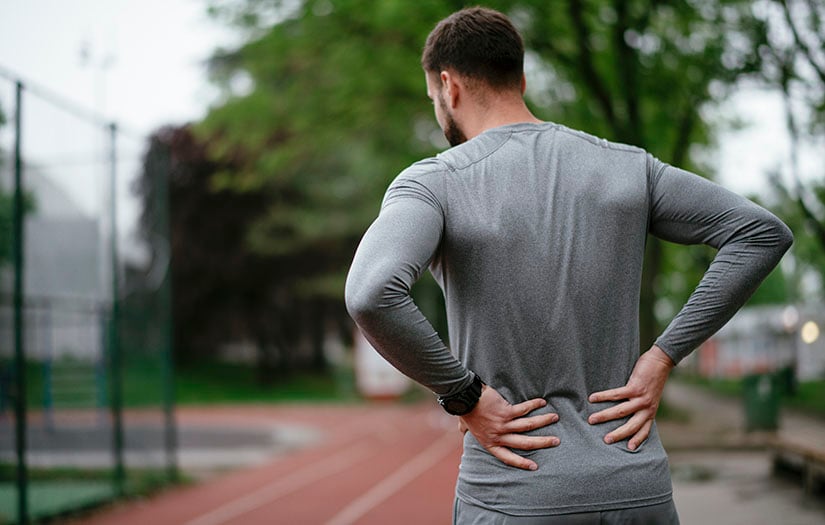If you’ve ever suffered from lower back pain, you know that it can be, well, a pain! The U.S. Department of Health and Human Services conducted a National Health Interview survey of 31,997 adults in 2019. Their reports showed that 39% of respondents suffered from low back pain, and the populations with the greatest risk were adults over 65, women, non-Hispanic white adults, and those with income below 100% of the federal poverty level.
Even though back pain is a common issue, the good news is there’s something that you can do about it.
This article will discuss some of the causes of low back pain and show you some lower back stretches and exercises to keep you healthy, strong, and hopefully, pain-free!
A pain-free lower back is a ticket to success for you or a potential clients you have. If you want to equip yourself with knowledge to correct movement-based pain, sign up for the NASM Corrective Exercise Specialization.
Low Back Pain and Corrective Exercise
Low back pain has many potential causes including muscle imbalances, decreased mobility, disc pathology, facet joint dysfunction, joint degeneration (spondylosis), and spinal instability (Cheatham & Kolber, 2016). To get a correct diagnosis of the cause of your back pain and proper treatment, it’s important to see your doctor. There are stretches and exercises that you can perform safely that indirectly address lower back pain by improving mobility, strength, and movement patterns.
A common question that clients ask me is, “If it’s my back that hurts, why aren’t we just focusing on that area?” It’s a great question! Very often, the site of the pain is simply a symptom and not the root cause. For example, someone who is seated for many hours in a row is likely to have low back pain not just because the back muscles are stiff, but because of shortened hip flexors.
Tight hip flexors can rotate the pelvis anteriorly (forward), which lengthens the glutes and alters the curvature of the spine. The low back muscles over-compensate for the glutes (which are rendered inactive by the anterior pelvic tilt) and the lower back muscles end up getting sore and tired from doing more than their fair share. In this case, the root cause of the back pain is overactive hip flexors and underactive glutes. By addressing the root issue, reduced low-back pain is often the by-product.
7 Corrective Exercises to Alleviate Lower Back Pain
- Foam Roll Adductors (Inner Thigh Muscles)
- Foam Roll Hip Flexors/Quads
- Foam Roll The Lats
- Glute Bridges
- Side Plank
- Bird Dog
- Squat to Row
The corrective exercise follows a specific order of operations for best results:
• Inhibit (or foam roll) the over-active muscles.
• Lengthen (or stretch) the muscles that you foam rolled.
• Activate (strengthen) the under-active muscles.
• Integrate or teach the muscle groups to function properly together for better movement.
In these exercise examples, we’ll follow this corrective continuum to address over-active and under-active muscles that typically lead to lower back pain.
Disclaimer: It’s outside of the scope of this article to diagnose or treat pain, but if you’ve already been treated by a physician and have been cleared for exercise, then give these a try. If at any point you feel pain or discomfort that is not tolerable, discontinue the exercise.
Foam Roll and Stretch These Muscle Groups:
#1 Foam Roll Adductors (inner thigh muscles)
See how to foam roll adductors here
• Lie face down with one knee bent, the foam roller just inside the knee on the inner thigh. Slowly roll the foam roller toward the groin, and then back toward the knee to find areas of tension in the muscle.
• When you find the most tender spot (but still tolerable to hold), hold it there for 30 seconds to 1 minute.
• Avoid areas where you feel a heartbeat, or any nerve-tingling sensations.
Stretch the adductors:
• Stand with feet wide, toes pointed straight ahead.
• Bend your knee on one side, and let the trailing leg stay straight to stretch the inner thigh.
• Hold the stretch for 30 seconds to 1 minute.
• Perform this same stretch seated, if needed.
#2 Hip Flexors/Quads
Foam Roll Hip Flexors/Quads
• Lay on the foam roller so that the roller is just below the top of your hip bone. Try to avoid rolling over bony areas. You can lie face down to hit the front of the hip flexors and quads, or you can be more on your side, which targets a muscle called the TFL.
• If you’re face down to target the front, roll down to the top of the upper thigh and back to find the most tender spot.
• If you’re on your side, slowly roll up and down a couple of inches, and rotate the hips back slightly to find the tightest spot.
• Once you’ve found it, hold still on that trigger point for 30 seconds to 1 minute.
• Repeat on the other side.
Stretch Hip Flexors/Quads
• Step one foot back into in a wide split stance, with the back toe pointed outward slightly.
• Tuck the hips under, and slightly press them forward as you reach straight up toward the sky with the hand on the same side as the back leg.
• For an additional stretch, rotate toward the back leg slightly.
• You should feel a stretch in the hip flexor, TFL, and the muscles along your side.
• Hold the stretch for 30 seconds to 1 minute.
#3 Lats
Check out how to foam roll lats here
• Lay on your side with your bottom arm extended straight, and the roller underneath your armpit area. Avoid rolling directly on the armpit- you’ll want to lean back slightly so the roller is just behind it.
• Roll a few inches down and back up to find the most tender spot.
• Hold it there for 30 seconds to 1 minute.
Stretch Lats
• Find a surface that’s close to waist-height and place your hands on the surface with the thumbs pointed up toward the ceiling.
• Bend at the waist and tuck the hips under as you drop your chest toward your thighs.
• You should feel the stretch in the lats.
• Hold the stretch for 30 seconds to 1 minute.
Activate
#4 Glute Bridge
Check out how to do a Floor Bridge by following the link!
• Lay with the knees bent, feet hip width apart, and palms up.
• Squeeze the glutes and bridge up until you have a straight line from your shoulder to your hip to your knee.
• Squeeze the glutes as tightly as you can at the top and hold for 2 seconds.
• Slowly lower down at a 4-second count.
#5 Side Plank
See how to do a Side Plank here.
• Lay on one side with the elbow directly underneath the shoulder, and thighs stacked.
• Bend the bottom knee for a modified plank (a great place to start!). The knee will stay down on the ground during the plank.
• Raise the hips up, squeeze the abs and glutes, and make sure that your body is in a straight line, with legs still stacked right on top of each other.
• Keep squeezing the abs and glutes, as you actively press away from the ground. Hold for 10-20 seconds.
• To make this harder, keep both legs straight and stacked on top of one another.
#6 Bird Dog
Check out how to do a Bird Dog here
• Get on all fours with the hands underneath the shoulders, and the knees underneath the hips.
• Draw your belly button in toward your spine and keep your core braced throughout the movement.
• Point the opposite arm and opposite leg out until they are completely straight, keeping neutral spine and neutral hips (no tilting or leaning).
• Hold that pose for 2 seconds before slowly lowering down.
• Brace the core and repeat on the other side.
Integrate
#7 Squat to row
Learn how to do a single-leg squat to row here
• Use a resistance band or cable machine for this exercise.
• Stand tall with feet hip to shoulder width apart, abs and glutes tight, holding the handles of your equipment.
• Slowly lower into a squat, keeping the chest tall and abs tight, and pause for 2 seconds at the bottom of the squat to check your alignment.
• Squeeze the glutes as you stand and row. When you get to the top, pause for 2 seconds as you pull your shoulder blades down and together and squeeze your glutes.
• Slowly straighten the arms as you lower into the next rep.
Example Corrective Exercise Programming for A Healthy Back
Perform the exercises in each category for the desired number of sets before moving on to the next category:
* Flexibility (Foam roll each area first, and then stretch each area)
| Exercise | Sets | Reps | Tempo | Rest |
| Adductors | 1 | 30 Seconds - 1 Minute | N/A | 0 |
| Hip Flexors/Quads | 1 | 30 Seconds - 1 Minute | N/A | 0 |
| Lats | 1 | 30 Seconds - 1 Minute | N/A | 0 |
Activate
| Glute Bridge | 1-2 | 10-15 Seconds | Slow | 0 |
| Side Plank | 1-2 | 10-15 Seconds | Slow | 0 |
| Bird Dog | 1-2 | 10-15 Seconds | Slow | 0-60 Seconds |
Integrate
| Squat to Row | 1-3 | 10-15 Seconds | Slow | 0-60 Seconds |
Which Lower Back Exercises Should You Avoid?
The simplest answer for this question is: avoid any exercise that causes pain. In addition to this simple guideline, there are some exercises that you should perform with caution if you’ve got lower back pain.
Avoid exercises that load the spine (like back squats), put excessive pressure on the spine (like supermen- where you lie face down and raise both arms and legs off the ground all at the same time), or exercises with forward or lateral flexion of the spine. The safest movements to try will be those that keep your spine in neutral alignment.
Is Walking a Good Option for Treating Lower Back Pain?
Yes! If your back pain isn’t in an acute flare-up, walking can help to increase blood flow and decrease back pain. It’s also a great idea to just keep moving in general. When we get “stuck” in a seated position, we put ourselves at risk of creating muscle imbalances that can lead to lower back pain.
Adopting a regular walking routine can help reduce back pain and improve your health, all at the same time.
Read also: Exercises for Knee Pain
References
Cheatham, S. W., & Kolber, M. J. (2016). Orthopedic management of the hip and pelvis. Elsevier.
Lucas, J.W., et al. (2021). Back, lower limb, and upper limb pain among U.S. adults, 2019 (Data Brief No. 415). U.S. Department of Health and Human Services.
National Academy of Sports Medicine (NASM). (2021). Corrective strategies for the lumbo-pelvic-hip complex. In Essentials of Corrective Exercise Training (2nd ed., pp. 378–383). Jones & Bartlett Learning.

















